This is a Veteran Owned site
![]()
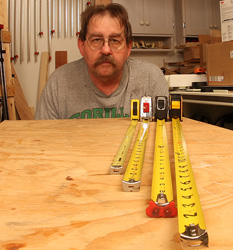 |
Is it possible that I know more than you about these tape measures? Maybe, for now anyway. Click image to enlarge |
Mystery Markings on Tape Measures
No, it’s not a plot to confuse us - maybe
Test and photos by Tom Hintz
Posted - 8-24-2011
Tape measures seem like very basic tools, perhaps even simplistic. But then we discover little black diamonds and other seeming unrelated symbols or color changes and our basic tape measure takes on an air of mystery. Many people simply disregard everything but the regular numbers thinking that if they needed the other markings they would already know what they represent. I think that if you know what those “other” markings mean you just might recognize use for them.
Regular Scale
Nearly all tape measures have the normal sequence of numbers along at least one edge of the tape. Some will have one resolution along one edge and another resolution on the other edge. Often you find 1/16” markings along one edge and 1/32” markings on the other. Some will have a “standard” (Imperial) scale along one edge and a metric scale along the other. You’d think that being able to see the metric equivalent every time we measured something that eventually we’d learn the metric system like everyone else in the world. Don’t hold your breath.
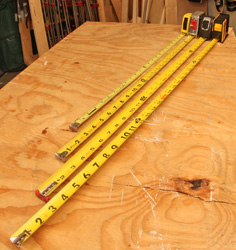 |
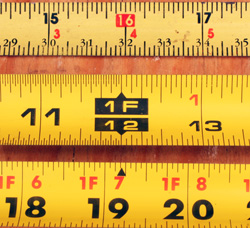 |
All of these measuring tapes (left) have similar marking schemes though the graphics used can vary slightly. In this photo (right) we see the mysterious Black Diamond on the bottom, a simple foot indicator in the middle and a 16" mark on top. Your tapes will probably have something approximating all of these. Click images to enlarge |
|
My favorite tape measure has a regular scale long the top edge of the tape and ½-scale centering markings along the other. If we measure an 18”-wide piece and find 18” on the lower scale and that indicates the center of that piece. Very fast and easy, two things I like a lot.
Standard tape scales usually have some kind of noticeable marking at 1-foot intervals. I think they do that to provide sort of a coarse scale that we can see easily when doing layouts. Once we get to the nearest foot indicator finding and making a layout mark at the exact distance is a bit faster.
Eight-Foot Spaces
Many tape measures add red numbers (or some other graphical standout) every 16-inches, a very common spacing for studs in house framing. This spacing allows for six supports in each 8-foot length. There may also be a color change or graphical identifier at 24-inch intervals that provides four supports in that same 8-foot length. While 16” spacing is standard for studs in low weight situations some building codes allow studs spaced 24” on center which can save a bit of money because fewer studs are needed. But full plywood sheets can still be used without cutting. Both of these spacing’s allow installing 8-foot-long sheets of plywood without cutting.
A standard concrete block chimney is two bricks by two bricks or roughly 16 inches square. That chimney won’t fit between studs that are installed on 16”-centers because there is only 14-1/2” between the studs. However, "Black Diamond Spacing" is ideal because the space between studs at that spacing is 17.7”. There is another use for the Black Diamond spacing as we will see later.
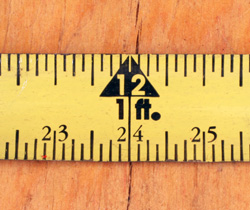 |
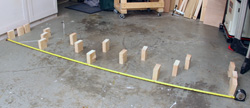 |
On the left is my daily use tape measure. Note the 1/2 scale along the bottom edge. That lets me find the center of a piece very quickly. In this case, find the 12 on the lower scale that is the center of a 12" board. Many time the sizes are not so simple and that lower scale saves the day. I have laid out an 8-foot-long wall (right) using the 16" marks (rear), Black Diamonds (middle) and 24" marks (front) to space the studs. Click images to enlarge |
|
Six supports can fit into an 8-foot space with 16” spacing while 24 inch spacing provides four supports in the same space. What if the load being supported requires that the trusses be spaced halfway between 16 inches and 24 inches? If they were spaced at 20 inches, they would not come out even at 96 inches. But there is an answer for this. Read on.
Black Diamonds
Probably the one tape measure marking that is most mysterious to the most people are the black diamonds. If you divide the 8-foot space we have been using by 5 we get a spacing of 19.2”. The black diamonds on the tape measure represent that spacing. The first black diamond is at 19.2” and after that black diamonds appear at 38.4”, 57.6”, 76.8” and 96”, or 8-feet. That is one less stud for every 8-feet of wall, counting the beginning and end studs.
While the black diamond spacing is nearly as weight capable as 16-inch-centers building codes may not allow it in all situations. Also, the black diamond spacing does not place a stud at 48-inches so standard 8-foot sheets of plywood must be installed with the long dimension horizontal.
In the Shop
Video Tutor |
While there may be few woodworkers (or metalworkers) that will ever frame out a house, knowing about these previously mysterious tape measure markings can come in handy. Ever try to locate studs on a wall only to discover that they are not on 16” centers? If you know about these other markings you know where to look for the next stud and why it might be at that distance. If you get roped into (volunteer for the married folks) building a potting shed knowing these alternative stud spacings just might come in handy. If nothing else you might be able to win a beer or something at the next club meeting.
Have a comment on this story? –Email Me!
All written, photographic and drawn materials are property of and copyright by NewWoodworker.com LLC 2000-2019. Materials may not be used in any way without the written permission of the owner.
